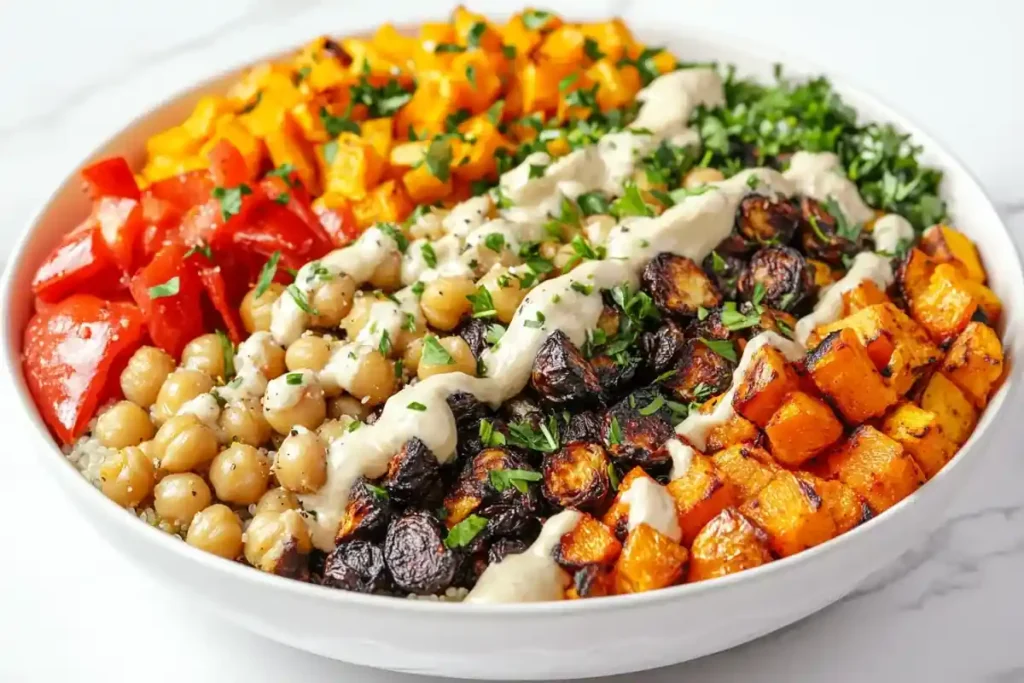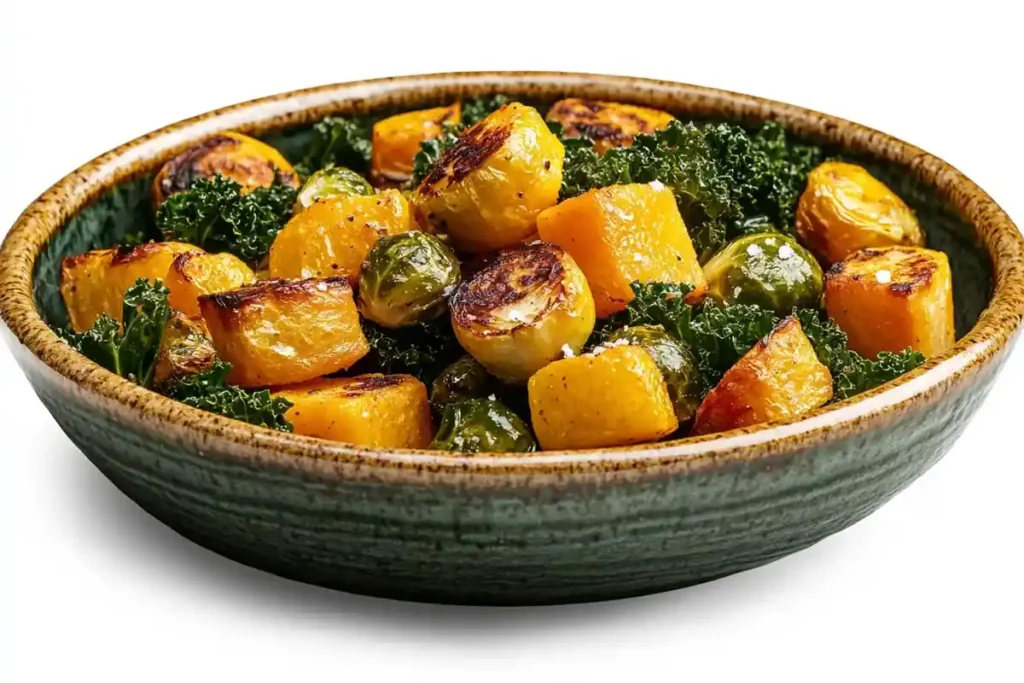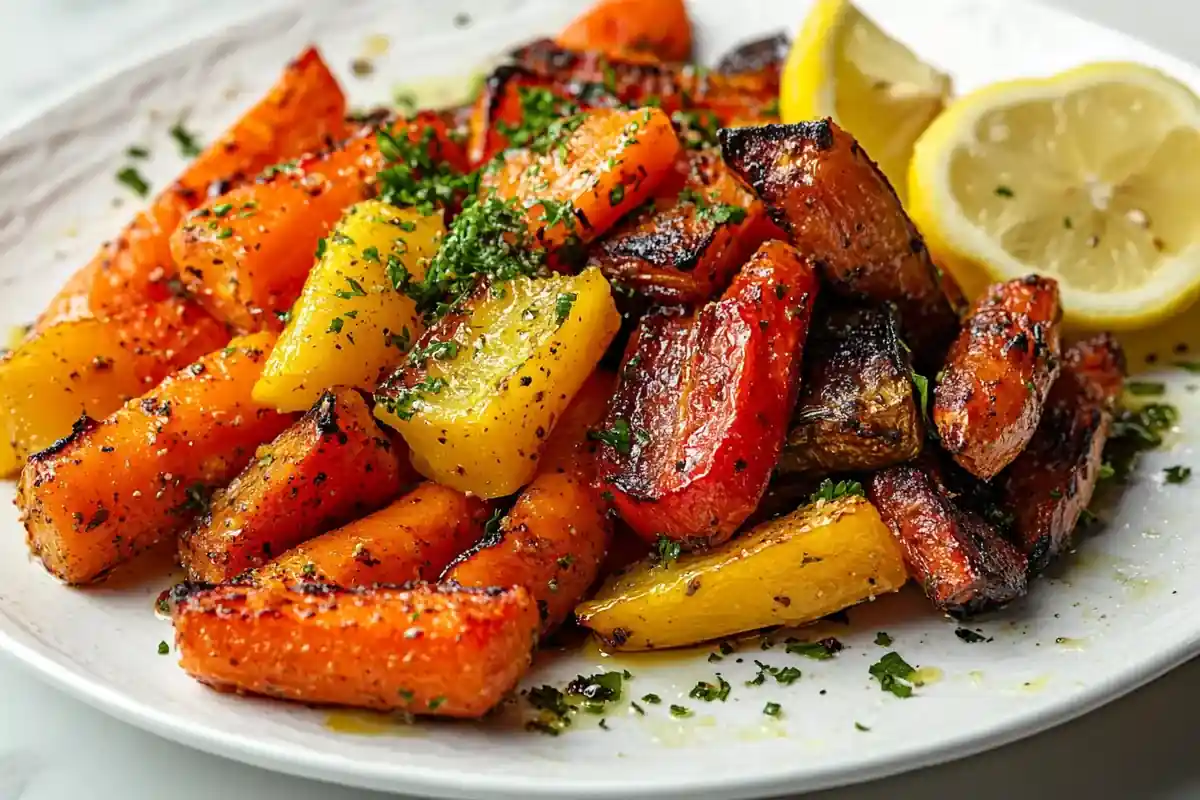Introduction
Vegetables are a vital part of a healthy diet, yet they often get labeled as bland or boring. But here’s the thing: with the right techniques, you can transform even the simplest veggies into vibrant, flavorful dishes that steal the show. From seasoning to presentation, learning how to jazz up vegetables opens up a world of culinary possibilities. In this article, we’ll explore creative ways to enhance vegetable dishes, covering everything from adding flavor to incorporating texture. You’ll also find an easy recipe for jazzed-up roasted vegetables that will make everyone at your table ask for seconds.
Why You Should Jazz Up Your Vegetables
The Importance of Eating Vegetables
Vegetables are not only nutritional powerhouses, but they are also packed with vitamins, minerals, and fiber that support overall health. For instance, eating them daily can aid digestion, boost immunity, and help maintain a healthy weight. However, despite these benefits, many people still struggle to incorporate enough veggies into their meals. Often, this is because they find them bland or uninspiring. Fortunately, with a little creativity and the right preparation techniques, vegetables can be transformed into delicious, exciting dishes that everyone will enjoy.When you jazz up vegetables, you’re not just making them taste better—you’re elevating their appeal and ensuring they’re a star player on your plate.
Making Vegetables Exciting
So, how do you jazz up vegetables to make them Compelling? The answer undoubtedly lies in flavor, texture, and presentation. For example, a simple sprinkle of spices, a drizzle of sauce, or even a splash of citrus can instantly elevate any vegetable. Moreover, by combining techniques like roasting, grilling, and sautéing alongside fresh herbs or crunchy toppings, you can effortlessly transform ordinary veggies into truly extraordinary creations. In this way, even the simplest vegetables can become a highlight of your meal. Plus, experimenting with different flavors keeps meals exciting, so you’ll never get bored of eating healthy.
Creative Ways to Add Flavor to Vegetables
Using Seasonings and Spices
When it comes to answering how do you jazz up vegetables, seasoning is the ultimate game-changer. A pinch of spice can truly transform the flavor profile of any veggie dish. For instance, try sprinkling smoked paprika, cumin, or turmeric on roasted vegetables to create an earthy, bold kick. Additionally, herbs like thyme, rosemary, or parsley can effortlessly add freshness and complexity. If you’re aiming for an Asian twist, a dash of soy sauce and sesame oil works wonders. On the other hand, for Italian-inspired flavors, opt for garlic and oregano to enhance your dish’s aroma and taste.
The key is to experiment with combinations. For example, roasted carrots become a gourmet treat with a blend of honey, chili powder, and a squeeze of lime. Don’t be afraid to explore spice blends like za’atar or herbes de Provence—they’re perfect for elevating everyday vegetables.
Incorporating Marinades and Sauces
Marinades and sauces are another way to boost vegetable flavor. A simple marinade of olive oil, balsamic vinegar, and Dijon mustard works wonders on veggies like Spring vegetable and zucchini. Alternatively, toss your vegetables in a creamy tahini dressing or a tangy vinaigrette before roasting. Sauces such as pesto, chimichurri, or a yogurt-based garlic sauce are excellent finishing touches for steamed or grilled vegetables.
For more delicious ideas, check out this roasted vegetable recipe.
Enhancing Texture for More Appeal
Adding Crunchy Toppings
Texture is as important as flavor when it comes to making vegetables more exciting. Crispy elements like toasted nuts, breadcrumbs, or seeds can add a satisfying crunch. Sprinkle some toasted almonds over roasted green beans, or add a handful of panko breadcrumbs to baked zucchini for a golden, crispy topping. These small additions make a big difference in creating a balanced dish.
Incorporating Creamy Elements
Balancing crunchy textures with creamy components takes vegetable dishes to the next level. For example, pair roasted Brussels sprouts with a dollop of whipped feta or a drizzle of cashew cream. Smooth dips like hummus or guacamole work well as side accompaniments for grilled or raw vegetables. These combinations not only add depth but also make the meal feel more indulgent and satisfying.
Elevating Vegetables with Creative Pairings
Pairing Vegetables with Grains
One way to jazz up vegetables is to pair them with grains for a complete and satisfying dish. Quinoa, farro, and couscous are excellent bases that soak up the flavors of your seasoned vegetables. For instance, roasted sweet potatoes and bell peppers tossed with quinoa and a lemon vinaigrette make a vibrant salad. Alternatively, pair grilled zucchini with herbed couscous for a Mediterranean-inspired side dish.
Combining grains with vegetables not only enhances flavor but also adds texture and boosts the nutritional value of your meal. For more grain-and-veggie recipes, check out Creative Ways to Use Leftover Rotisserie Chicken for Quick Meals.
Adding Proteins for a Balanced Meal
Proteins are essential for turning a vegetable dish into a full meal. Grilled chicken, tofu, or lentils complement roasted vegetables beautifully. For a vegan-friendly option, pair your veggies with chickpeas or black beans. For example, a warm salad of roasted cauliflower, chickpeas, and tahini dressing is both hearty and flavorful.
Experimenting with protein options ensures versatility, whether you’re meal prepping or creating a family dinner.
Incorporating International Flavors
Asian-Inspired Vegetable Dishes
Asian cuisine, without a doubt, offers countless ways to jazz up vegetables with bold and complex flavors. For example, stir-frying not only highlights the vibrant colors but also enhances the natural sweetness of veggies. Additionally, incorporating soy sauce, sesame oil, and a touch of ginger can create an authentic taste that’s hard to resist. Furthermore, for a more dynamic dish, consider tossing broccoli and snap peas in a sweet chili glaze or a miso-based sauce to add depth and excitement to your meal.
Pair these dishes with rice or noodles to complete the meal. For inspiration, explore this guide to Asian-style vegetable stir-fries.
Mediterranean-Inspired Creations
The Mediterranean diet is famous for its fresh and flavorful vegetable dishes. Roasted eggplant drizzled with olive oil and topped with crumbled feta is a classic choice. You can also create a vibrant mezze platter with grilled veggies, hummus, and pita bread. Adding fresh herbs like parsley and mint enhances the flavor profile of these dishes.
To discover more Mediterranean-inspired vegetable recipes, consider visiting related articles on the website.
Enhancing Vegetables with Sauces and Toppings
The Power of Sauces
If you’re asking How do you jazz up vegetables?, sauces are often the answer. A well-crafted sauce can transform plain vegetables into a flavorful delight. Creamy tahini, tangy yogurt-based dressings, or bold pesto can elevate roasted or steamed vegetables. For instance, drizzle a lemon-dill yogurt sauce over roasted carrots for a refreshing twist. Alternatively, coat your veggies with a peanut sauce for a rich and nutty flavor.
Adding sauces is a quick and versatile way to experiment with different cuisines, ensuring your vegetables never feel boring.
Crunchy Toppings for Texture
Texture undeniably plays a crucial role in making vegetables more exciting. For instance, adding crunchy toppings such as toasted nuts, seeds, or crispy breadcrumbs not only enhances the contrast but also brings a delightful balance to the soft, roasted vegetables. Moreover, these toppings provide a layer of complexity that transforms a simple dish into a gourmet experience. For example, sprinkle sesame seeds on stir-fried broccoli or crushed almonds on roasted Brussels sprouts.
Incorporating toppings not only enhances the taste but also adds a nutritional boost with healthy fats and proteins.

Creative Cooking Techniques for Vegetables
Grilling and Charring
Grilling vegetables is an excellent way to infuse them with smoky flavors. Vegetables like zucchini, eggplant, and Spring vegetable develop a unique taste when grilled. For even more depth, brush them with a marinade before grilling. Charring, on the other hand, adds a slightly crispy texture and caramelized edges to veggies like bell peppers and corn.
Grilled vegetables can be served as a side dish or used in other recipes, such as wraps or grain bowls.
Roasting and Glazing
Roasting vegetables in the oven is a go-to method for bringing out their natural sweetness. To jazz them up further, try glazing them with honey, maple syrup, or balsamic vinegar. For instance, roasted carrots with a balsamic glaze create a savory-sweet balance that’s Compelling.
Experimenting with different cooking techniques not only enhances flavor but also helps you find new ways to enjoy vegetables in your meals.
Pairing Vegetables with Proteins and Grains
Why Proteins and Grains Are Key
Proteins and grains are essential components that elevate vegetable dishes from simple sides to satisfying, balanced meals. Proteins provide the necessary building blocks for muscle repair and energy, while grains offer a hearty base to complement the lighter texture of vegetables. When paired, they ensure a complete meal that keeps you full and energized.

Balancing Nutritional Needs
Vegetables are rich in fiber, vitamins, and antioxidants, but they often lack substantial protein or complex carbohydrates. Adding proteins like grilled chicken, tofu, or lentils fills this gap, making the meal more nutritionally balanced. Similarly, incorporating grains such as quinoa, barley, or brown rice provides a steady source of energy through complex carbs.
Enhancing Flavors
Proteins and grains also serve as flavor carriers, absorbing spices, marinades, or dressings. For example:
- Roasted vegetables paired with marinated tofu take on the rich flavors of the marinade, creating a harmonious dish.
- Grains like couscous or farro can be cooked in vegetable broth or mixed with herbs, enhancing the overall flavor profile.
Examples of Perfect Pairings
- Roasted Vegetables and Grilled Salmon: The buttery texture of salmon complements the caramelized edges of roasted vegetables.
- Vegetable Stir-Fry with Quinoa: A quick and healthy option where quinoa adds a nutty taste and fluffy texture.
- Stuffed Bell Peppers with Rice and Chickpeas: This dish combines grains and legumes for a filling and flavorful meal.
Incorporating Seasonal Produce
Using seasonal vegetables is a surefire way to add fresh, vibrant flavors to your dishes. Seasonal produce is often more affordable, environmentally friendly, and packed with nutrients due to being harvested at peak ripeness.
Why Seasonal Matters
- Flavor Profile: Seasonal vegetables taste better because they’re fresher and haven’t been stored for long periods.
- Cost-Effectiveness: Locally grown, in-season vegetables are usually less expensive due to reduced transportation and storage costs.
- Nutritional Value: Produce grown in its natural season retains higher nutrient levels, maximizing health benefits.
Seasonal Pairing Ideas
- Spring: Combine Spring vegetable, peas, and carrots with bulgur wheat for a refreshing salad.
- Summer: Toss roasted zucchini, eggplant, and bell peppers with orzo pasta for a Mediterranean-inspired dish.
- Fall: Use roasted butternut squash and Brussels sprouts alongside wild rice and dried cranberries for a cozy autumn meal.
- Winter: Pair roasted sweet potatoes and kale with quinoa for a hearty, warming bowl.
Creative Tips for Seasonal Variety
- Experiment with Spices: Adjust spices to highlight the unique flavors of seasonal produce. For example, use cinnamon with winter squash or dill with spring Spring vegetable.
- Add Seasonal Fruits: Include fruits like apples in fall dishes or citrus in winter recipes to add brightness and sweetness.
- Explore Farmers’ Markets: Shopping at farmers’ markets is an excellent way to discover seasonal produce and gain inspiration for your meals.
By combining proteins, grains, and seasonal vegetables, you can craft meals that are not only delicious but also balanced, nutritious, and visually appealing. These thoughtful pairings ensure you’ll never run out of exciting ways to enjoy vegetables!
Using seasonal produce is an easy way to keep your meals exciting and full of variety.

Inspiring Recipes to Jazz Up Vegetables
Recipe: Spiced Roasted Vegetable Bowl
This recipe is a vibrant answer to How do you jazz up vegetables? It combines a variety of spices, grains, and a zesty dressing for a satisfying dish.
Ingredients:
- 2 cups chopped seasonal vegetables (e.g., zucchini, carrots, bell peppers)
- 1 tablespoon olive oil
- 1 teaspoon smoked paprika
- 1 teaspoon ground cumin
- 1/2 teaspoon garlic powder
- Salt and pepper to taste
- 1 cup cooked quinoa
- 1/4 cup hummus
- Lemon wedges (for serving)
Instructions:
- Preheat the oven to 400°F (200°C). Line a baking sheet with parchment paper.
- In a large bowl, toss the vegetables with olive oil, smoked paprika, cumin, garlic powder, salt, and pepper.
- Spread the vegetables evenly on the baking sheet. Roast for 25-30 minutes, turning halfway through, until tender and slightly caramelized.
- To assemble, layer cooked quinoa in a bowl, top with roasted vegetables, and add a dollop of hummus. Serve with a lemon wedge for extra zest.
Nutritional Information (per 100g):
| Nutrient | Amount |
|---|---|
| Calories | 120 kcal |
| Protein | 4 g |
| Carbohydrates | 18 g |
| Fat | 4 g |
| Fiber | 3 g |
Exploring New Recipes
By trying recipes like stir-fries, grain bowls, or soups, you’ll discover countless ways to enjoy vegetables. Whether you’re roasting, grilling, or steaming, each method offers endless possibilities to elevate the humble vegetable.
Let me know if you’d like help with any additional sections or have specific ideas in mind!
FOR MORE DELICIOUS RECIPES:
VISIT OUR WEBSITE Pampamrecipes.com

